Green Building Community
Humidity, Hardwoods and Homes - The Building Science Approach to Protecting your Investment (Video)
Posted by: Rate It Green Team
Proper humidity is critical for building product condition and durability, just as it’s important for human comfort and health. Do you know the ideal humidity for your hardwood floors and how to manage humidity to protect your investment? Our experts do, and they’re sharing what they know.
We were fortunate to bring together a panel of building, air systems, and flooring experts to discuss key information to know about how water and water vapor enter homes and the built environment generally, what we can and should do (and not do) about this intrusion, and also what the ideal conditions are for our wood floors and other furnishings.
If you’d like the whole story, check out the Humidity, Hardwoods and Homes video on our YouTube Channel. You can also read below for key concepts and conclusions!
Thank you to our amazing "Humidity, Hardwoods and Homes” Panelists:
Joseph Hillenmeyer
Senior Channel Marketing Manager
Aprilaire
National Wood Flooring Association (NWFA)
Brett Miller
VP of Technical Standards, Training & Certification
Matt Hoots
President
Sawhorse, Inc.
A key lesson from this presentation is that we need to protect the floors under our feet at the same time we protect the air we breathe. What’s really interesting is that when it comes to controlling humidity, many of the same key concepts are relevant for people and building materials, and the equipment and actions we need are largely the same.
As Brett Miller of the National Wood Flooring Association (NWFA) is points out, "Wood flooring is a barometer of everything that is happening in that home from an environmental perspective,” and a barrier we’ve invested in and should protect. Brett also reminds us that wood flooring is very visible, once of the first things we see and something we all walk across. Wood shows us when humidity is extreme, as it expands when it absorbs moisture and shrinks when it releases moisture. If a home is too dry, the wood will crack and split, stretch/gap and possibly experience finish delimitation. If a home has too much moisture, wood can swell, cup, and buckle. However, it’s a good idea to maintain optimal indoor air quality conditions, including humidity, before we see these effects and distortion or damage has occurred of course, whether to flooring, furnishings, furniture, doors, or woodwork.
How does water vapor get into homes?
Matt Hoots explains how uncontrolled air and moisture comes into and out of buildings. Moisture enters buildings through roofs, walls, windows, and foundations. Some of this intrusion is inevitable, but much of it can be reduced. We do want ventilation and air circulation, but leaks represent uncontrolled air, which can bring in or release moisture to create detrimental conditions. Water itself can also of course enter a building due to ground conditions, improper drainage around the perimeter or downspouts, wet trade activities or materials, or spills.
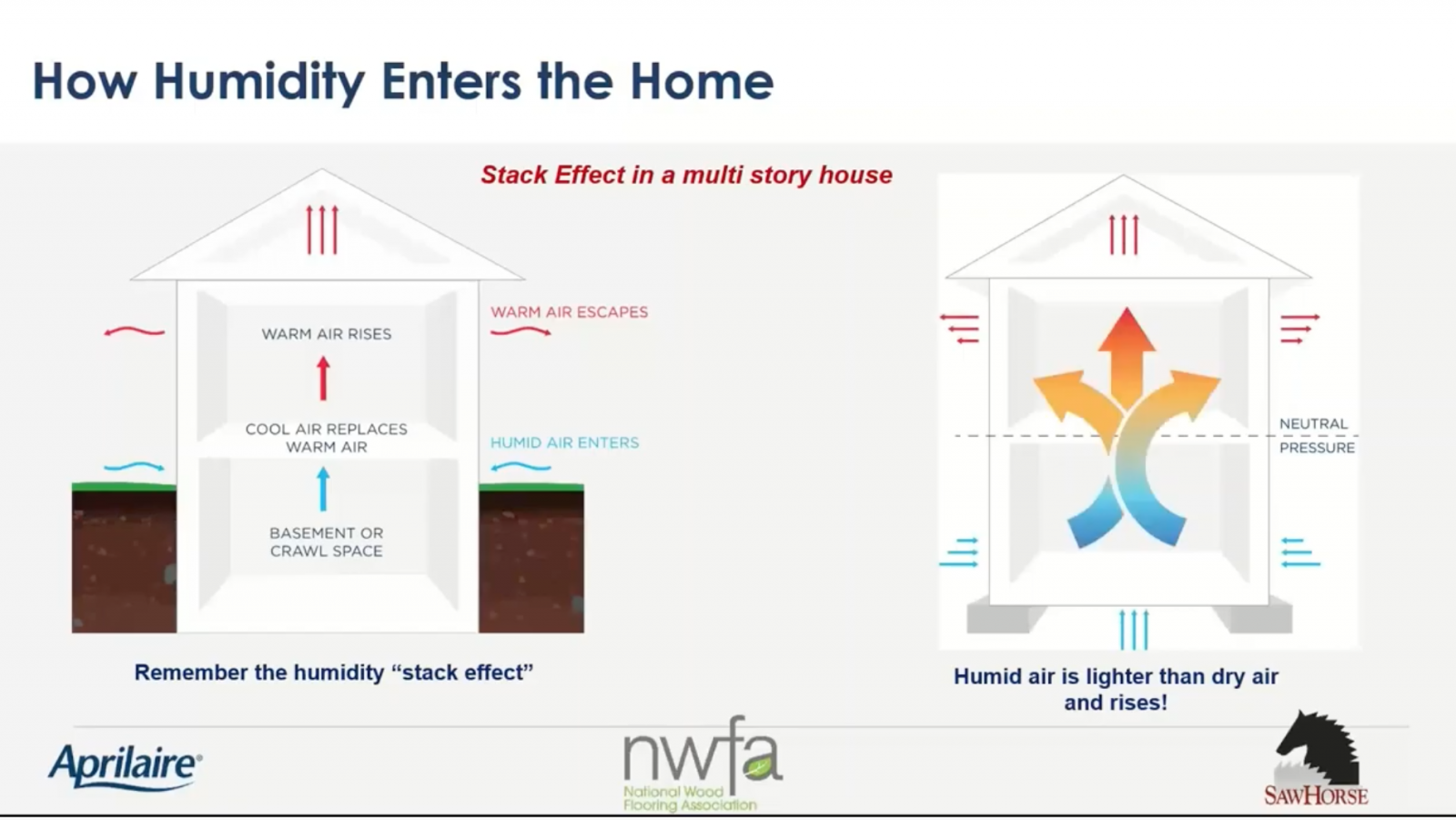
Source: Southface Institute
The #1920sMakeoverATL Deep Energy Retrofit project provides a great example of a leaky home, and Matt and his teammates will be sharing how they turn this leakiest home in the area into one of the most energy efficient in the zip code! At the foundation level, water can enter as bulk (built up) water, or also in vapor form.
Have you wanted to know more about the Stack Effect? Matt explains how vapor moves from areas of high pressure to low pressure, creating a need for make up air to replace the warm and rising, escaping air. If not conditioned, this outside air might be quite humid.
He also explains diffusion, the process by which water vapor moves through the materials assembly at a slow rate, or “perm rating.” A 0 perm rating means no water is getting through.
When infiltration is happening through actual holes in the building, then the hole sucks in the air, which brings in the outside humidity with it and can change the humidity/ water vapor conditions inside the house. Over a month, 1/3 of a quart of water might pass through a 4 x 8 sheet of drywall through diffusion. But with just a 1” square hole penetration, 30 quarts of water might pass through at the same time! This is why all holes need to be sealed up and the different control layers implemented properly.
.png)
Source: Southface Institute
What we can we do to “stop” water vapor from getting into homes?
Actually, that’s a trick question. In most conditions, some vapor intrusion is inevitable. So our goal will be to allow water to go through materials at the appropriate rate so it can dry out properly. We do not want water stuck in the wall. If we do stop water 100%, it can pool and conditions such as mold and rot can develop.
Air moves from areas of high pressure to areas of low pressure, from high temperature to low temperature, areas of high humidity to areas of low humidity. In the winter, this means from inside to out. In the summer, this generally means from outside to in.
Convention is heat transfer from the movement of water, fluid, or air. In a leaky house, theres lots of convection. Convection loops, where air rises along warm surface and falls along cold ones, causes circular movement which shifts humidity and heat and can reduce insulation effectiveness.
A key point is that with good insulation and air sealing, proper ventiltion, which includes proper balanced suplies and returns in your HVAC system, and balanced fresh air ventilation, many of these factors won't matter because you're controlling the airflow and pressure.
How can we reduce building air leakage?
It’s important to lower the rate we’re losing air so we don’t lose conditioned air we’ve paid for literally out the window. Air leakage requires a hole and then also pressure difference across that hole. To reduce leakage, we need to lower the pressure difference (which we can’t always control - wind creates pressure, for example), or reduce the size of the hole, though a tight building envelope. A positive pressure balance can push out conditioned air, where a negative pressure balance can bring in unconditioned air. Tightening methods include air sealing, a vapor barrier, control layers for water, vapor, and air, and insulation. A blower door test will show how tight a building is, or isn’t.
Protecting wood floors from below
All of this air and water movement affects wood floors, as wood reacts to moisture. Brett Miller points out that a key way to control that moisture is to address what’s going on below the floor. Did you know that 50% of the air that comes into a building enters through the foundation? To, prevent excess moisture intrusion, a vapor retarder can be used on a wood subfloor. Again, retarders slow the diffusion process. They don’t stop moisture altogether, as stopping can create a place for moisture to build up, which can cause mold growth, subfloor rot and decay, and even degradation. This said, it’s never acceptable to install a retarder over a moisture condition or to use one to remedy a moisture condition.
What are the ideal interior conditions for wood flooring?
All wood contains some moisture. Where a living tree is 30-200% moisture, the wood of course must be dry enough to maintain a consistent physical property to be used as a flooring product. How do we find the right balance, and what are the ideal interior conditions for wood?
It’s important to understand that the moisture content of wood depends on the amount of moisture in the air, which is known as relative humidity, or RH. In a high RH environment, wood absorbs moisture, and in low RH wood releases it. Joseph describes air with low RH as “thirsty.” It will pull moisture from anything around it that has humidity. For wood this can be cracking and checking. For people, this can mean pain and itchiness in heir eyes, nose, and throat. Another result of low RH is that viruses can become more infective, as they hang in the dryer air longer. Additionally, less moist air can lead to static shock, which can even damage electronics.
RH that is lower than ideal also causes problems. Wood can swell or rot, as we’ve discussed. But mold, mildew, dust mites, and termites thrive in RH over 50%. As for human comfort, a lower temperature without lower humidity creates a cold and clammy feeling that is not comfortable.
It turns out that the ideal humidity range for wood is the same as for human comfort and health, 30-50% humidity. The ideal temperature is between 60 and 80 degrees. In these conditions, wood moisture content will be about 6 to 9%. It’s important to maintain these conditions as closely as we can, as repeated cycles of wood absorption and release history the shape of wood.
It’s important to understand that different climate zones present different control challenges, and these also change during the year. It’s especially important to have dedicated humidity control equipment when moisture might be higher but conditioning equipment might not be running.
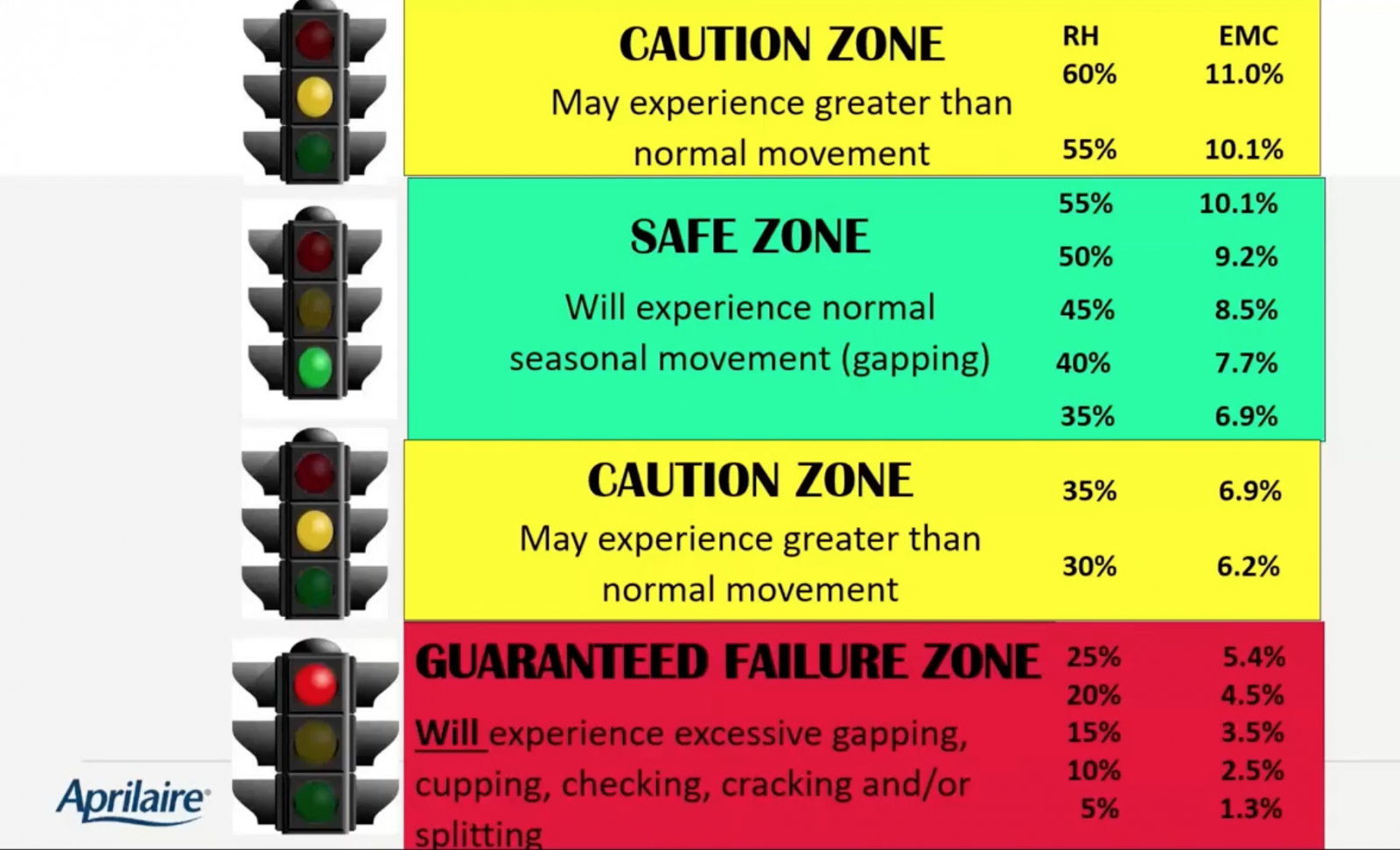
Temperature Control Equipment is Often not the Ideal way to Manage Relative humidity (RH)
Temperature control equipment manages absolute humidity, or the amount of moisture in its vapor form in the air, where relative humidity - percentage of the amount moisture the air can possible hold (expressed as a %). Since warmer air can hold more moisture, people often try to remove moisture for the air by cooling, but the result is often over cooling, where the moisture isn’t sufficiently reduced and so occupants are therefor not comfortable as intended. Joseph explains why this doesn’t quite work as a part of a Rate it Green video on Whole House Humidity Control. The goal of the thermostat is to change the temperature. It can affect humidity some, but this isn’t it’s goal. This is why we often need dedicated solutions that add or remove moisture from the air.
Types of Dedicated Humidity Control Equipment
Joseph walks us through different types of Aprilaire humidity control equipment, as well as the benefits of each type. Arilaire also offers WIFI enables solutions and controls for ease of operation and maintenance.
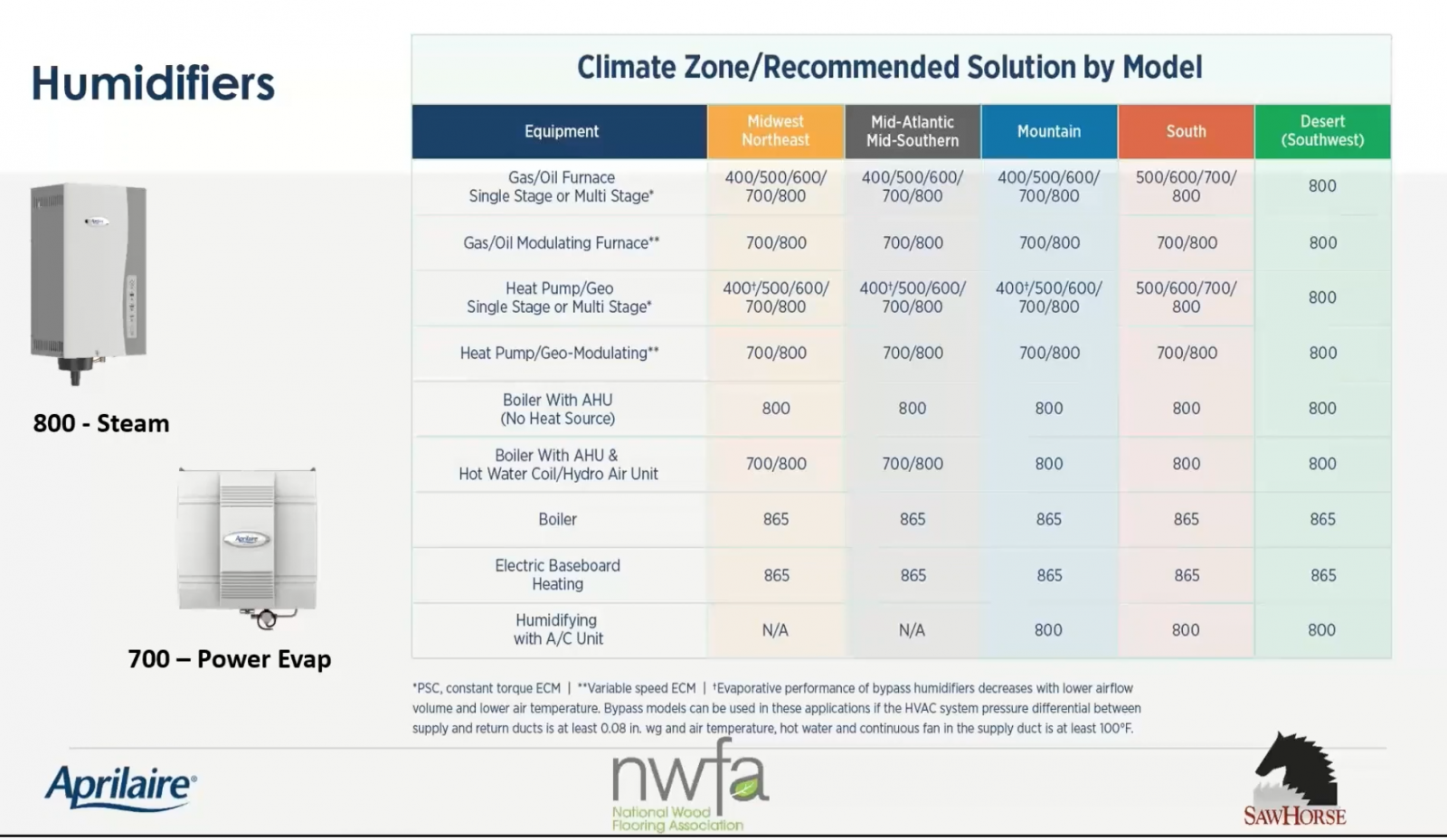
Evaporative humidifiers (used more in climate zones 6, 7, and 5) use heat and air flow to turn water from a liquid to a gas, which is hen distributed through an HVAC blower though the home.
Steam humidifiers use electric current to heat water from a liquid to a gas, which is dispersed using HVAC blower or w a dedicated fan. Steam humidifiers are good for large applications or independent of heating (arid climate).
Dehumidification can be high capacity of ventilation. Benefits of both with respect to wood flooring include:
- Reduce risks and odors caused by high humidity
- Protect wood by keeping moisture levels down
- Aid air conditioning effectiveness by reducing latent loads
- Save on energy costs by allowing home comfort to be at higher temperatures
- Operate during morning and evening as well as spring and fall when air conditioners aren’t running due to low temps - when humidity can still be high
How do you pick the right equipment? It’s important to start with the climate zone and also the size and tightness of the structure. These factors will determine how much moisture you need to add to the air. (Also: Post your questions, and Joseph will also be happy to help you!)
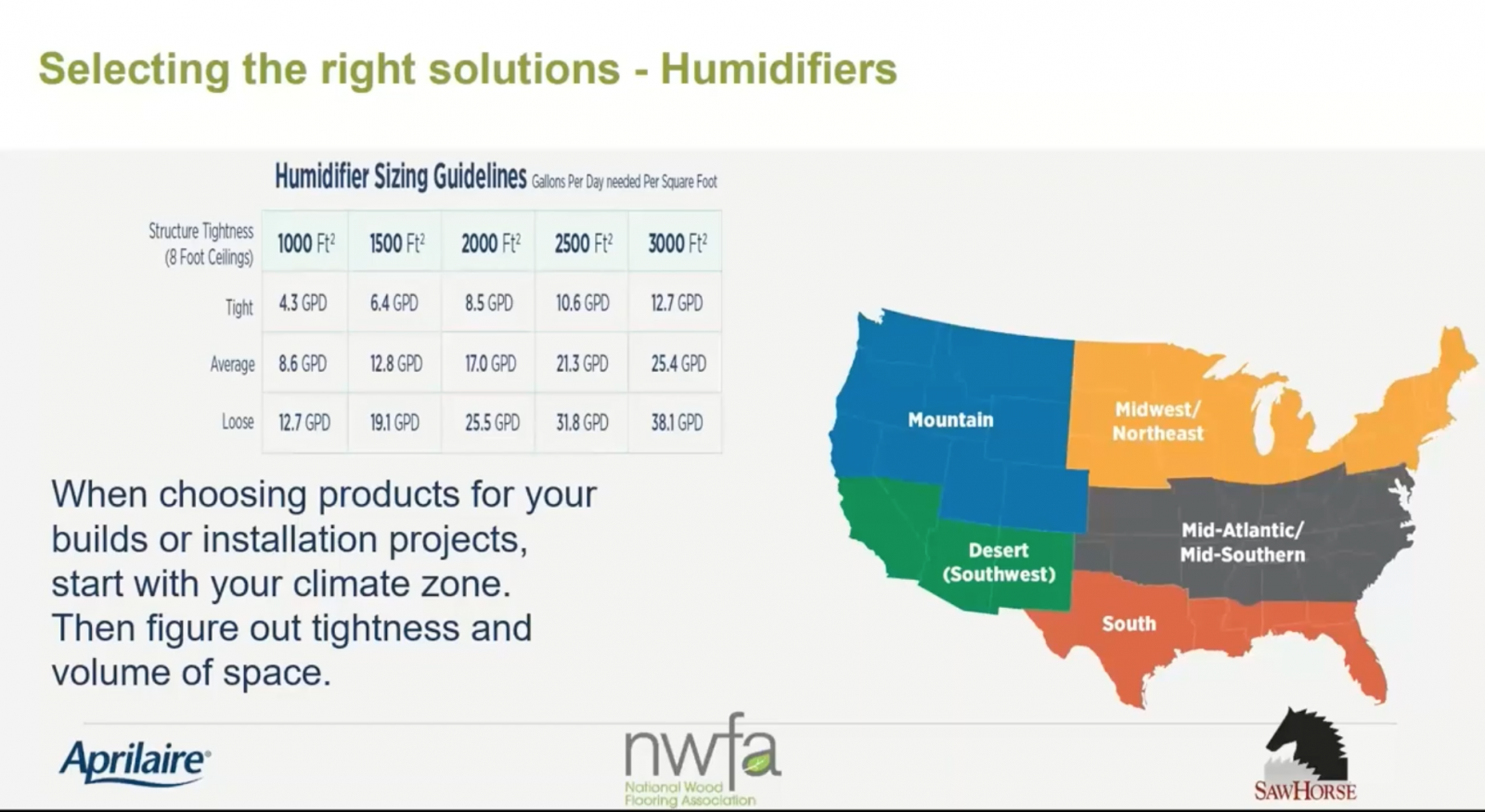
Keep in mind that one of the toughest variables in predicting performance is… people. Ask how a home will be lived in, and what the cooking, cleaning, bathing, and laundry habits are likely to be?
And finally, it’s important to monitor conditions. A lot of HAC equipment is “set and forget,” but only measurement will show us when something is amiss.
Reviewing benefits to proper humidity control
Wood flooring performs its best given the right, consistent combination of RH, temperature, and moisture content. There are of course other benefits to proper humidity control, including better indoor air quality to support human health, increased comfort, the preservation of other furnishings and building materials, odor reduction, and pest and mite control.
Fortunately, people and wood flourish in much of the same ideal range - 30-50% humidity. The ideal temperature for wood flooring is between 60 and 80 degrees. In planning tighter structures, the idea isn’t to stop air and moisture from coming into our buildings, but to properly control and condition this air in order to maintain healthy conditions, operate to meet our goals as efficiently as possible, and to preserve our investment.
Watch the video to benefit from the full Q&A Session. Here are some highlights:
Q: To confirm, humid air is lighter than dry air? (yes)
Q: Should one use a liquid and sheet vapor barrier (We want to retard, not stop vapor)
Q: Is there a checklist to check for ideal conditions installed wood floors? (Yes, NWFA has a job site checklist available free for members, and also to non members for a fee)
Q: Define loose and tight homes?
Q: How long would humidity be at failure to see effects? (Faster for higher humidity, hours or days, days or weeks for lower humidity)
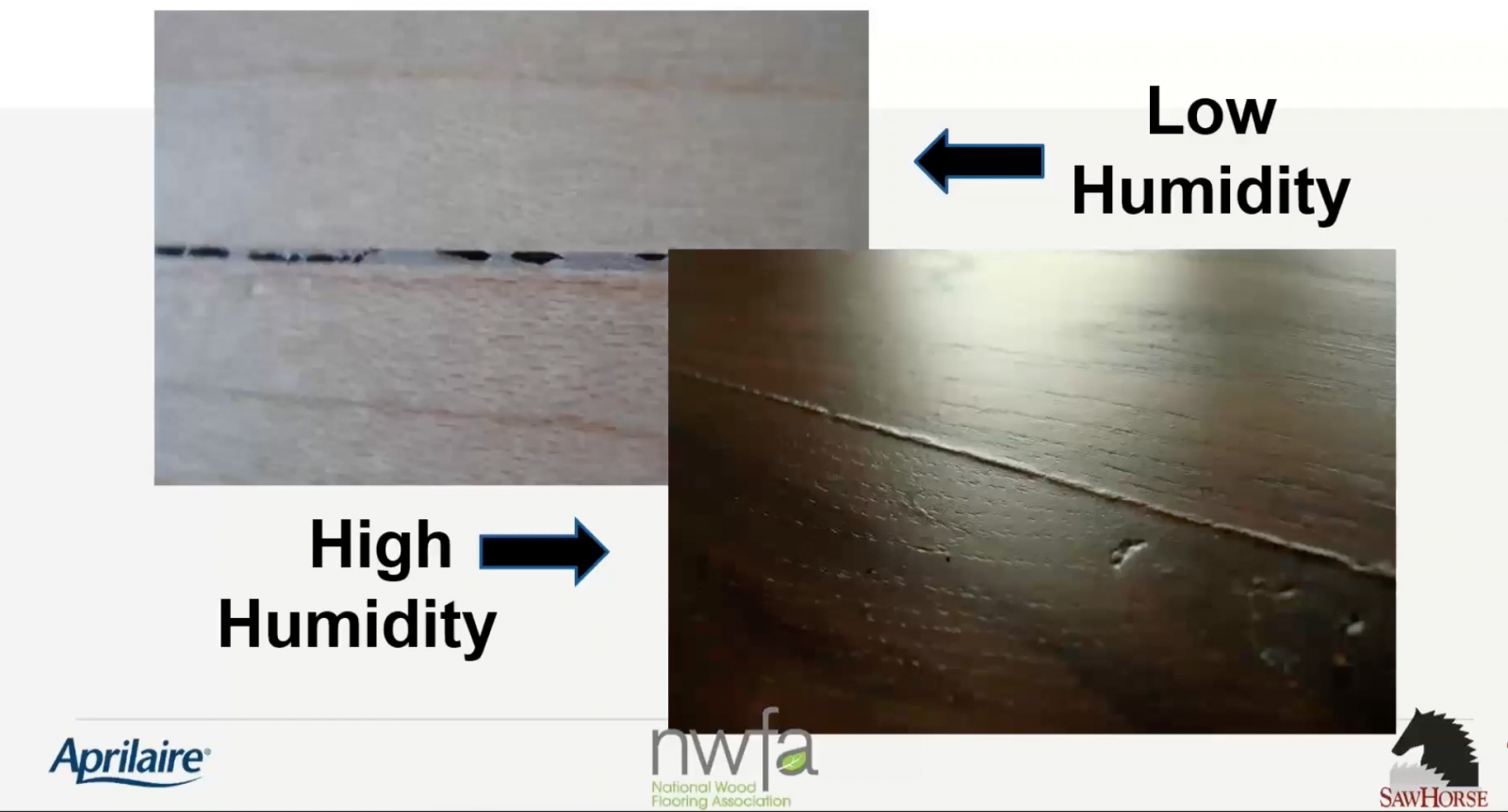
To learn more about Aprilaire, visit their Rate It Green profile:
https://www.rateitgreen.com/green-building-directory/sustainable-building-companies/aprilaire-a-division-of-research-products-corp/7888
For additional information about humidity and ventilation:
Whole House Humidity Control - Dehumidification and Humidification, with Aprilaire (Video)
An Introduction to Aprilaire and Whole House Air Quality Systems (Video)
VIDEO: A Look at How ERVs Work with Panasonic, How 80% Efficiency Might Work in Practice
Air Filtration at the #1920sMakeoverATL Showhouse - It Can Only Get Better from Here (Video)
Exploring Whole House Filtration and Particulate Matter, with Aprilaire (Video)
Air Filtration at the #1920sMakeoverATL Showhouse - It Can Only Get Better from Here (Video)
VIDEO: Spot Energy Recovery Ventilation (ERV) - Designed for One Location (vs Whole House)
Reviewing the Top Benefits of Healthy Air at Home, with Aprilaire (Video)
Walking and Talking about Fresh Air and Ventilation with Green Building Expert Matt Hoots - and Oliver
Green Building Myth Busting: Natural Ventilation - Do Your Walls Need to "Breathe?" (Video)
Your House May be Making You Sick!
What is the ideal humidity needed to help maintain hardwood flooring? (Q&A)
Thank you to Southface Institute for sharing visual explanations to support with Matt Hoots' presentation.
Please be kind and respectful!
Please make sure to be respectful of the organizations and companies, and other Rate It Green members that make up our community. We welcome praise and advice and even criticism but all posted content and ratings should be constructive in nature. For guidance on what constitutes suitable content on the Rate It Green site, please refer to the User Agreement and Site Rules.
The opinions, comments, ratings and all content posted by member on the Rate It Green website are the comments and opinions of the individual members who posts them only and do not necessarily reflect the views or policies or policies of Rate It Green. Rate It Green Team Members will monitor posted content for unsuitable content, but we also ask for the participation of community members in helping to keep the site a comfortable and open public forum of ideas. Please email all questions and concerns to admin@rateitgreen.com

